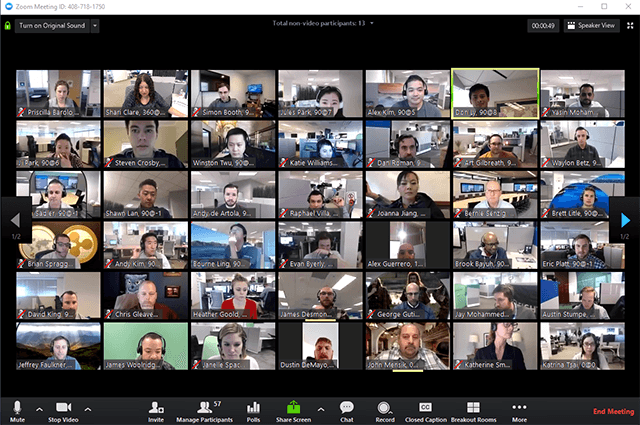Four Models for Course Delivery
There are four broad models presented here for course delivery: in-person, hybrid, remote, and hyflex (short for “hybrid-flexible”). The sections in this document describe the principles of each model, their possible strengths and weaknesses, and references to recent discussions about implementation.
This table gives a synopsis of how synchronous (activities that happen at the same time) and asynchronous (activities where participants are working at different times) fit together for each mode:
| In Person | Hybrid (flipped) | Remote | HyFlex | |
|---|---|---|---|---|
| Asynchronous | Readings, Homework, Quizzes | Readings, Homework, Quizzes + Recorded Lectures |
Readings, Homework, Quizzes + Recorded Lectures, Other videos, Discussions |
Readings, Homework, Quizzes + Recorded Lectures, Other videos, Discussions |
| Synchronous | All students attend face-to-face | All students attend face-to-face | All students attend online | All students attend online; some attend face-to-face |
What Is an In-Person Class?
Traditionally, students are assigned asynchronous activities to do outside of class; these usually consist of homeworks and readings. Then, the entire class meets in person at a set time for lectures and other learning activities. This model requires all students to be physically present throughout the term.

Strengths
- Instructors are most experienced in this model
- Existing and incoming students are familiar with it and expecting it
- Pedagogy around in-person delivery is well-tested and well-developed
- Traditionally gives instructors the most autonomy, less technological and pedagogical support needed
Weaknesses
- Does not offer flexibility for instructors and students
- Cannot reach students who cannot be available residentially
- Requires supporting and leveraging physical infrastructure
- Traditionally, does not take advantage of innovative pedagogies
Recent discussions around in-person delivery:
- IHE articles on novel in-person models for Autumn: choosing specific classes to offer in person; offering only graduate courses; offering only first-year courses

What Is a Hybrid (“Flipped”) Class?
A flipped class takes the less interactive learning experiences from in-person classes and makes them asynchronous. Most commonly, this means pre-recording lectures that students watch asynchronously. The aim is to spend in-person class time on active learning, such as Q&A, debate and discussion, simulations, role-playing, and other group work.
A variation on this model further leverages remote learning by having some of those class sessions remotely, requiring students to come in person to class less frequently. For example, students might come only a few times a quarter. This low-residency mode uses those in-person meetings as intensive immersions where students enjoy the benefits of the residential experience in a compressed time frame.
Strengths
- Done properly, uses residential time most effectively and efficiently
- Leverages affordances of in-person and remote modes and takes advantage of technologically-enhanced pedagogies
- May offer more flexibility to students and instructors if online content is used to decrease in-person instruction time
- Can be a transitional step towards creating a fully-remote class
Weaknesses
- Offers more flexibility, but still requires students and instructors be available for in-person experience
- Requires supporting and leveraging both online and physical infrastructure
- Requires greater investment from instructors to create asynchronous content
- Requires more technological and pedagogical support to create and deliver
Recent discussions:
- IHE article on low-residency model for Autumn
- Article from UT Faculty Innovation Center on what a flipped classroom is and how to go about designing and developing
What is a Remote Class?
A remote class has no in-person interactions. Its shape is varied, but usually they mix remote asynchronous and synchronous learning activities.
In addition to readings and homeworks, the asynchronous activities might include discussions on discussion forums, videos from the instructor and students, and quizzes. Then, all students meet synchronously via Zoom with the instructor at a set time.

Strengths
- Offering a majority of Asynchronous material gives students maximum flexibility about when they learn
- Reaches students who cannot be physically present
- Little or no physical infrastructure required for teaching
- Done well, entails thoughtful design where instructor evaluates the best learning activities and tools for the desired learning outcomes, instead of loading most activities into synchronous meetings
- Can leverage innovative tools and pedagogies–everything from personalized learning to virtual worlds
Weaknesses
- Can easily be an inferior learning experience to in person without proper and robust development by instructor
- Modality is unfamiliar to most instructors and students
- Requires instructor willingness to adapt and learn new pedagogies
- High-quality asynchronous content requires large investment from instructors and support staff to develop
- Students may expect different tuition given different modality
Recent discussions around remote:
- IHE articles around adapting for fully remote for the Autumn quarter
- UChicago guidance on transitioning to remote learning

What is a Remote Class?
A HyFlex class is a twist on hybrid and remote modalities:
- It is hybrid, meaning that it combines in-person with remote learning.
- It is flexible, meaning that the learners decide themselves to participate remotely or in-person on any given week of the course.
Two principles of this model are choice (students determine how they participate) and equivalency (learners online and in-person have equivalent experiences, even if they are different).
In practice, asynchronously, all students do learning activities like watch pre-recorded videos and participate in discussions.
Students decide how to join the live class. Some choose to meet in-person in the classroom with the instructor; some choose to connect to the class remotely via Zoom.
Strengths
- Gives students agency over whether they participate in person or remotely
- Reaches students who cannot be physically present
- Ensures that remote and in-person students interact
- Allows students who are able to take advantage of affordances of in-person learning
- If circumstances change, can easily be adapted to go fully in person or fully remote
Weaknesses
- Requires supporting and leveraging both online and physical infrastructure
- May require investment in classroom infrastructure to support remote students (video equipment, microphones, etc).
- Requires instructor willingness to adapt and learn new pedagogies
- High-quality asynchronous content requires large investment from instructors and support staff to develop
Important considerations and Recent discussion around the HyFlex model:
- Should the online and in-person meetings be conducted simultaneously or separately?
- How can instructors be supported for in-person and remote formats?
- How can instructors be supported to create enhanced asynchronous content?
- What changes are needed to ensure equivalent learning experiences for in-person and remote students?
- Discussion in IHE
- Phill Hill’s recent discussion of the model and its principles
- The history of the HyFlex model from one of its pioneers